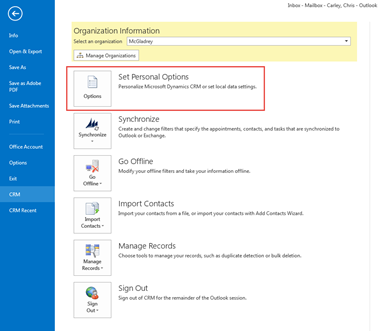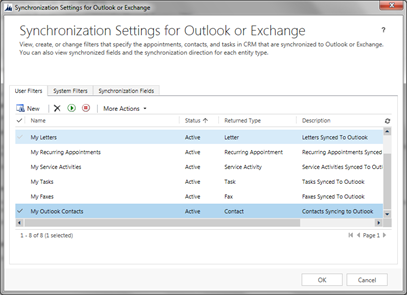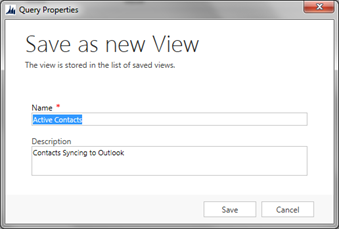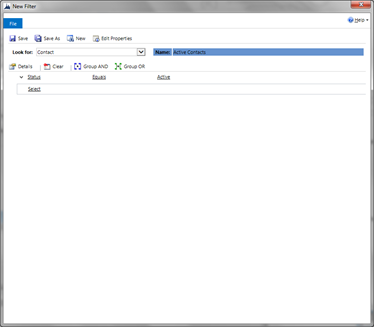I recently had a client in the Real Estate Development market where we implemented Microsoft Dynamics CRM 2015. This was a small organization of only 7 users, having roughly 2,500 contacts, and they only used Microsoft Dynamics CRM for Contacts and Accounts. Their old solution did not allow all users to easily see all Contacts and Accounts within their organization. Being in the Real Estate Industry, they were always on the go and also needed the mobile functionality that Microsoft Dynamics CRM offered.
During training, a few of the users mentioned how the Dynamics CRM mobile application took a while to actually open, and users wanted the mobile functionality to be able to call a contact quickly from their phone. So a colleague and I suggested the simple solution of syncing all Contacts to the users Outlook, then Outlook Contacts to their phone.
There are many considerations and questions that arise regarding this. Please use your best judgment if implementing this in your organization. Listed are only some of many considerations.
- There are security risks associated with having this functionality and I would highly recommend all users mobile devices are password protected.
- Check with your organizations rules and regulations regarding having this type of sensitive information on user’s phones.
- This assumes users have the correct security roles to see all or specific contact records.
- This assumes users have a smartphone.
- These instructions are using screenshots from Microsoft Outlook 2013.
- This assumes users have the Outlook client for Microsoft Dynamics CRM installed and setup.
- Please reference our blog, Installing and Configuring the Outlook client for Microsoft Dynamics CRM for Optimal Performance, for instructions on how to install the Outlook client for Microsoft Dynamics CRM. If you have Office 365 Subscription, please note this blog, Installing the Outlook client for Microsoft Dynamics CRM – Office 365 Subscriptions, when setting up the Outlook client.
- This is assuming the sync functionality is already turned on for the organization’s Dynamics CRM system, the default sync settings are activated, and there are no other sync settings interfering with syncing all active contacts in the organization.
- This will need to be done in each user’s Outlook that would like the functionality of seeing all contacts in the organization to take effect.
- If users have contacts in their Outlook that are also in Dynamics CRM, I would highly recommend backing up and removing those contacts from users “People” section in Outlook before syncing. This will prevent confusion on which is the up to date contact record.
Step 1: In Outlook, start by going to File, then CRM, click on “Set Personal Options”.

Step 2: Make sure the Synchronize option is checked and set the desired automatic synchronization time.

Step 3: Next, click on Filters at the top of the window.

Step 4: Once the window pops up, scroll down to My Outlook Contacts and open that by clicking directly on My Outlook Contacts. In this example we are just renaming an already existing filter. You could create a new one just as easily and deactivate the existing My Outlook Contacts to avoid confusion between filters.

Step 5: Click edit properties at the top of the window and change the name to Active Contacts. Click Save, which will save and close the window.

Step 6: Next, click the down arrow next to Owner in the below filters, and delete that row. Again, in this example we are just syncing all active contacts in Dynamics CRM. You can use this filter to better fit the user or organizations needs of the contacts wanting to be synced to Outlook.

Step 7: Your filter should now look like the below image with Name: Active Contacts and the filter only having Status Equals Active. Click save to save the changes, then you may close out of the filter window.

Step 8: In the users smartphone settings, enable contact syncing from their outlook (exchange) account if not already enabled. Settings may vary depending on the type of smartphone.
Step 9: After all this has been setup, go to the CRM tab in Outlook and click Synchronize with CRM.

Once that is done Syncing, go to the contacts application on the phone and search for a contact you know is in Dynamics CRM and not on the user’s phone. If that contact appears, the setup was successful. If you have questions about these instructions, please leave us a comment or contact our professionals at 855.437.7202.
By: Chris Carley – Minnesota Microsoft Dynamics CRM partner

 RSMUS.com
RSMUS.com